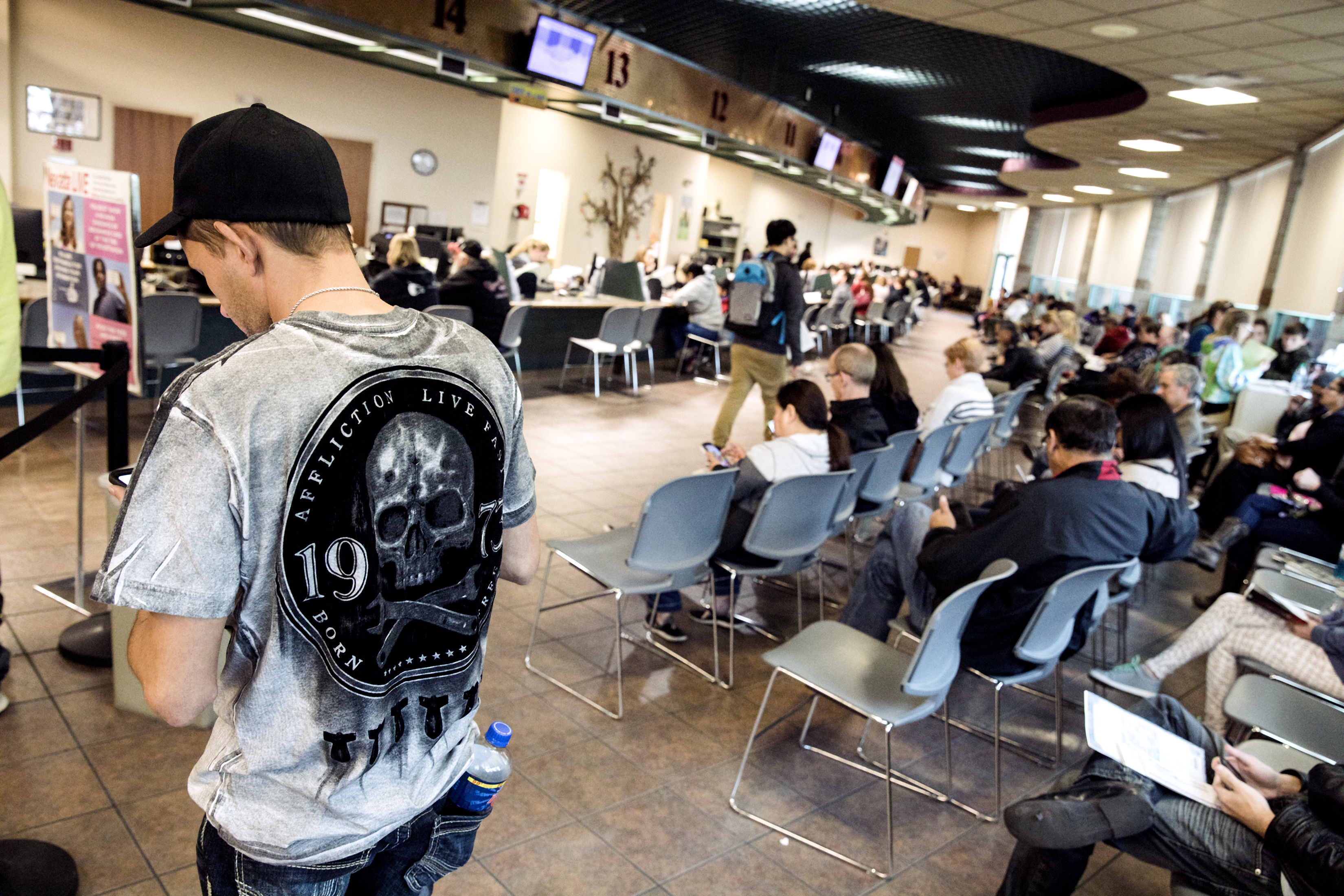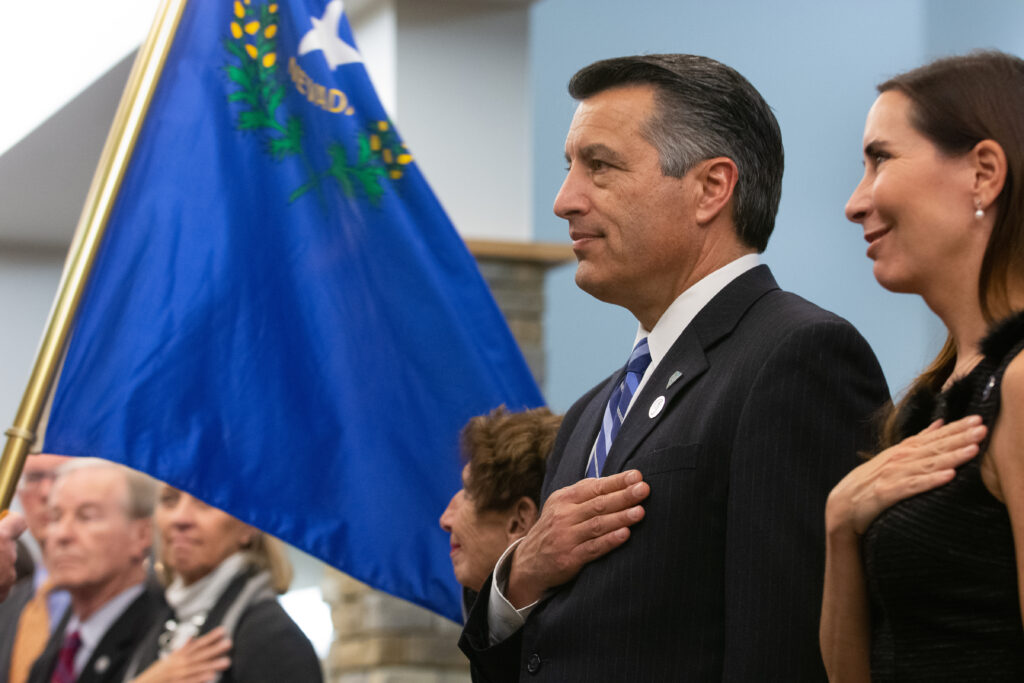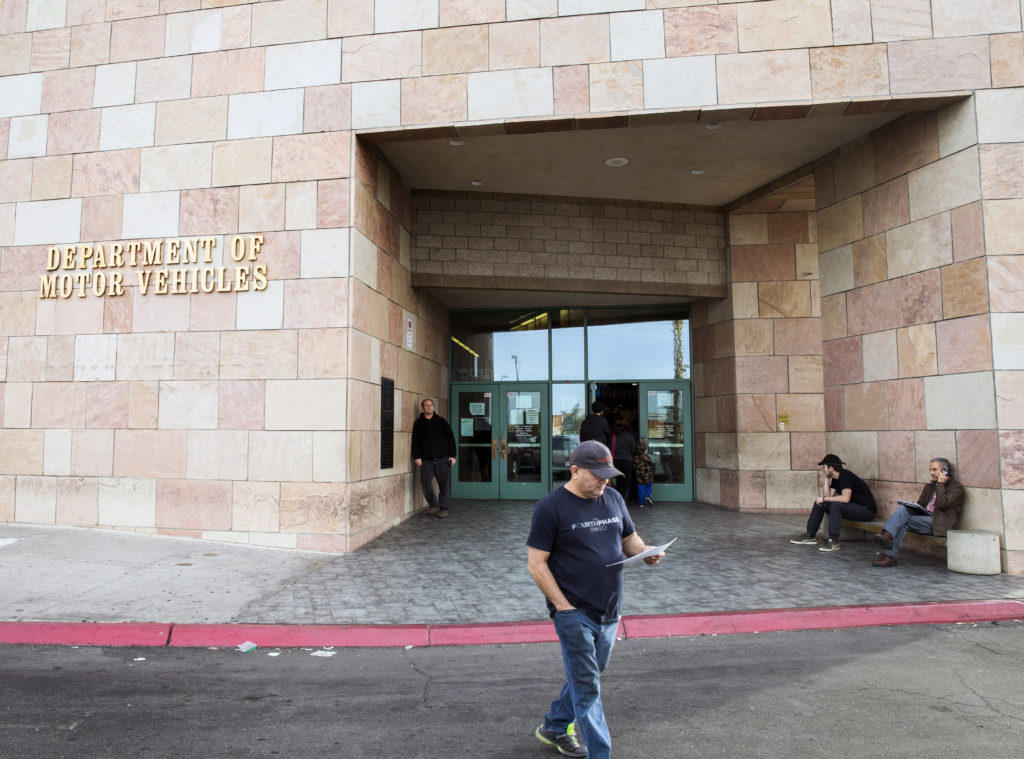Voter rolls swell as automatic registration takes effect

Thirty-year-old construction worker Jesse Speights walked into the Reno DMV on Monday, not knowing if he was even registered to vote.
When he walked out shortly afterwards, he was officially a registered nonpartisan, one of the first customers to undergo what he called a “quick and easy” process under Nevada’s new automatic voter registration law (click here for a video explainer of that). But while he affirmed that “voting’s cool” because you can pick the leader of the U.S., he wasn’t sure he would do it in November.
“Maybe ... we’ll see,” he said.
Speights is among thousands of new voters added to the rolls in January, driven primarily by new nonpartisans, but also by a smaller number of Democrats and Republicans. The surge of well over 6,000 new voters in Clark County during the first 10 days of January was close to the average amount the county saw in an entire month under the prior system. The increased registrations appear to be because under the new law, people who complete DMV transactions automatically have their voter records updated unless they opt out.
Although the early numbers could foreshadow a strong turnout and possible trouble for the Republican Party, which is seeing its ranks grow more slowly relative to other party registrations, it is uncertain how many of the newly registered voters will show up at the voting booths. Many have no prior experience casting a ballot.
Professor David Damore, chair of UNLV’s political science department, said turnouts for elections in Nevada are low and voting process reforms making it easier to vote usually have “marginal” effects. For example, Nevada’s voter participation rates remain low even after the expansion of early voting and addition of competitive races and heavy campaign spending, he said.
“The best predictors of voting are residential stability, age, and education and Nevada is a very transient state, is 45th in college grads, and some segments of the state's population, particularly Latinos, are relatively young,” he said. “Most people who are interested in politics, understand the process, and are in the habit of voting, do participate. There are just fewer of those types here than in other states.”
Nonpartisans turn out at lower levels than those affiliated with a major party. Voter turnout for registered voters in Nevada’s 2016 general election for Republicans was 73.6 percent, for Democrats was 67.6 percent, and for third-party and nonpartisan voters was 57.5 percent.
Voter turnout rates are usually higher for elections held during a presidential or on-cycle election. The DMV said it does not have estimates for how many voting-age Nevadans who are unregistered will become registered through the new law, although Clark County Registrar of Voters Joe Gloria testified in 2017 that he estimated up to 120,000 new voters in Clark County would be registered through AVR, based on Oregon’s experience with the policy.
In Clark County, which holds the bulk of registered voters totaling over 1.1 million, roughly 6,100 new nonpartisans, 3,400 Democrats and 1,700 Republicans were added to the pool of active registered voters in January as of Jan. 18. That translates to a 0.76 percent increase of new registered Democrats, a 0.54 percent increase in Republicans, and a 2.4 percent increase in nonpartisan voters.
A Trump Victory spokesman said in an interview on Wednesday that the campaign is not worried about the sheer numbers of newly registered Democrats and nonpartisans because the party predicts that in terms of proportions, the percentage breakdown of party affiliations will stay more or less the same.
Trump campaign spokesman Keith Schipper also hinted at a plan to reach out to conservative-leaning nonpartisans and lauded the GOP’s sophisticated voter information database, saying it “gives us that much more of an advantage understanding which issues resonate with nonpartisan voters.”
Nevada as a swing state
Nevada has gone for the winning candidate in every presidential election in the last 108 years except for the elections of 1976 and 2016, when Nevada voted for Gerald Ford over Jimmy Carter and Hillary Clinton over Donald Trump.
Nevada’s vacillations between parties in presidential elections have demarcated the state as a swing state. However, a growing non-white electorate — which tends to vote more Democratic — combined with the fact that Nevada went blue in the past two election cycles have left some wondering whether the swing state designation is still accurate.
Many Democrats and Republicans, however, still view Nevada as a battleground state. Nevada’s pivotal early state status in the presidential nomination process — the Silver State is the third state to vote in the upcoming Democratic caucuses and primaries — mean a steady flow of candidates are including Nevada on their campaign stops.
Republicans point out that Democrats winning statewide in Nevada typically take more moderate stances than their peers in other states.
“If Gov. Sisolak would’ve run on gun confiscation and health care for illegals, I think you would say he would’ve lost this race … This is what the Democrats nationally are running on,” Rick Gorka, a spokesman for the Trump Victory Campaign, told The Nevada Independent in an interview in Nov. 2019.
Gorka said he believes the state is still in play in spite of Democrats’ marquee victories in Nevada in 2018.
“When you look at where the 2020 field is now, I think Nevada is a much more competitive place today than it was a year ago. That’s just me being honest about it,” Gorka said.
Damore, however, said Republicans will struggle not just with a numbers disadvantage, but a Democratic Party that has been relatively successful turning out even hard-to-turn-out voting blocs.
“Participation among many Democratic constituencies is uneven and requires a good deal of investment in [get out the vote efforts],” he said. “The problem for the GOP is that there are not enough Republicans to offset the Democrats' demographic advantage and the party's superior machinery.”
Early setbacks

The proposal to automatically register voters at the DMV faced setbacks before it ultimately became law. Though it passed the Democrat-controlled Legislature in 2017, Republican Gov. Brian Sandoval vetoed the so-called “motor voter” petition when it appeared on his desk.
Sandoval said he vetoed the measure over concerns the law would “increase the possibility of improper registration” and change the DMV process, which already includes access to voter registration. Under the prior “opt-in” system, voters had the opportunity to register at the DMV; the new system updates a person’s registration unless they proactively “opt out.”
Sandoval also said that he wanted the public to decide the matter because the new law would affect them directly. A majority of Nevada voters approved the automatic voter registration measure when it was on the statewide ballot in 2018, sending it to victory with a margin of 19 percentage points.
But fears that the automatic system might sweep up non-citizens still persist, including for Brandon Blankenship, a 55-year-old Libertarian from Sparks.
“My largest concern is registering voters who are not legally here in the country or who may have some other restrictions that aren’t vetted properly here at the DMV,” he told The Nevada Independent outside the DMV earlier this week.
Originally from California, Blankenship cited accidental ineligible voter sign-ups in California as a reason for caution regarding automatic voter registration.
Preventing non-citizens from registering
Nevada DMV spokesperson Kevin Malone said there are safeguards in place to ensure that ineligible voters are not registered.
Per Nevada DMV procedures, eligible voters, also referred to as “electors,” are provided an “Automatic Voter Registration (AVR) Options” form after filling out their application for driving privileges, renewal, or change of address. The form enables customers to opt out of AVR, in which case the transaction will not be used to register to vote or to update their party affiliation with the secretary of state.
Customers who do not opt out, who do not already have a party affiliation or who do not specify a party affiliation on the AVR Options form are registered with the secretary of state absent a party preference.
Customers who submit documents that deem them ineligible to vote, such as a permanent resident card or any documentation indicating the person will not be 18 years old by the next election, are excluded from the AVR system and their documents are not sent to the secretary of state. Instead, the customer receives a Notice of Ineligibility print-out, with information on alternative ways to register (such as through the secretary of state website) if the customer believes they are indeed eligible.
There is also a checkbox on the DMV application that asks whether the applicant is a citizen. A negative answer would result in exclusion from AVR.
The exclusion of Driver Authorization Card (DAC) holders from AVR has raised concerns among voting rights groups. DACs, which authorize a person to drive but cannot be used as formal government identification for other purposes, are commonly used by non-citizens.
Last year, Mi Familia Vota, the national Voting Rights Project of the ACLU, Demos and the Brennan Center for Justice raised concerns that excluding DAC holders and applicants might exclude eligible voters from AVR. Advocates said that AVR should not be denied based on whether a customer holds a DAC, but rather that DAC holders should be allowed to affirm eligibility to vote, under penalty of perjury.
Although the DMV moved forward with excluding DAC holders from AVR after the public comment period, the process is such that documents submitted in past transactions indicating that the customer is a non-citizen, are not considered by the AVR system for new transactions, allowing for the possibility of AVR for those whose status has changed since their last transaction.
Malone says that eligible DAC applicants who want to register or update their registration “will be provided assistance by staff in completing a voter registration form that is processed separate from the AVR System.” Furthermore, applicants will be screened out of the AVR process during a transaction based only on the identification they present during that same transaction.
“This approach ensures that someone who has naturalized since their last DMV transaction will not be improperly denied the opportunity to participate in the AVR process, based on the identification they presented prior to being naturalized,” said a letter submitted by the Brennan Center for Justice in October 2019.
How are voters reacting to AVR?

The Nevada Independent interviewed voters at DMV offices in Reno and Las Vegas about two weeks after automatic voter registration took effect on Jan. 1, 2020. Although some voters were excited about the new policy, others, such as Richelle Claughton, were more wary.
“I don’t know. It’s just … seems like a little too automatic for me, because it just feels like more personal information is out there. I’ve had my identity stolen before. Somebody went to college on it in another state, and somebody worked on my social in another state,” said Claughton, a commercial class A driver and a longtime Democrat. “It feels like there’s like a loophole somebody could use to probably get access to my personal stuff.”
Retired law enforcement officer Glen Davis said although he appreciates the attempt to register more voters, he does not believe increased registered voters will correlate with increased voter turnout.
“Is it gonna change participation? No, because those who wanted to participate would have registered by the means that were available,” he said. “So, even with automatic registration, if they don’t wanna participate, they’re not gonna participate.”
Dwight Cabanilla, a Truckee Meadows Community College student, said he thought automatic voter registration was beneficial for voters who may not know where to register.
“I think [automatic voter registration is] a huge benefit,” he said. “Especially if [people] don’t really know or aren’t registered. It’s something that can really help.”
Cabanilla also noted that once people register to vote, “it’s up to the people to really get the information that they need to really figure out the kind of candidate that they want to vote for.”
Sixty-four-year-old Mark Service, a newly registered voter, echoed Cabanilla’s sentiment that automatic voter registration was positive and hopes automatic voter registration laws will get more voters to the polls.
“Knowledge is power,” he said. “I think everybody should vote. I don’t think enough people do. And, the ones who don’t and complain about it — it irks me.”



